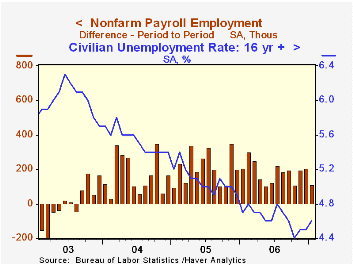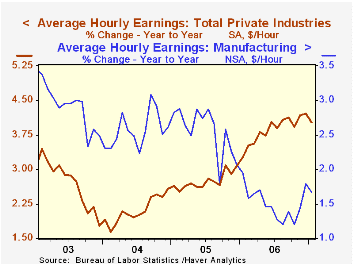 Global| Feb 02 2007
Global| Feb 02 2007January Payrolls Missed Forecast, Revisions Upward
by:Tom Moeller
|in:Economy in Brief
Summary
Nonfarm payrolls grew by 111,000, an increase that was short of the Consensus forecast for a 140,000 rise, but the prior two months' gains were upwardly revised by a collective 81,000. The unemployment rate increased last month to [...]

Nonfarm payrolls grew by 111,000, an increase that was short of the Consensus forecast for a 140,000 rise, but the prior two months' gains were upwardly revised by a collective 81,000.
The unemployment rate increased last month to 4.6% from 4.5%. Household employment rose just 31,000 (2.0%) following the 303,000 surge in December, while the labor force grew 199,000 (1.9% y/y). The number of individuals not in the labor force jumped 343,000 and that increase more than reversed the declines in the prior two months. As a result, the labor force participation rate fell to 66.3%.
From the establishment survey, the job gain of 111,000 was the weakest in three months. Private service sector jobs rose just 90,000 (2.0% y/y), held back by a light 4,000 (2.0% y/y) gain in financial sector jobs and an even lighter 3,000 (0.7% y/y) uptick in information services. Professional & business services employment grew 25,000 which was also down from the increases of the last two months (2.9% y/y) and temporary help services jobs rose 5,700 (1.0% y/y) while jobs in retail trade rose just 4,000 (-0.2% y/y).
Factory sector payrolls fell again. The 16,000 worker decline was the seventh down month in a row.
Warmer temperatures helped construction employment to rise by 22,000 (1.3% y/y) and the prior month's decline was revised to a 10,00 gain.
Government payrolls increased 14,000 (1.3% y/y) but the prior month's gain was revised down.
Average hourly earnings halved December's gain with a 0.2% increase. Factory sector earnings fell 0.5% (+1.7% y/y) after an upwardly revised 1.0% December gain.
| Employment | January | December | Y/Y | 2006 | 2005 | 2004 |
|---|---|---|---|---|---|---|
| Payroll Employment | 111,000 | 206,000 | 1.6% | 1.9% | 1.7% | 1.1% |
| Manufacturing | -16,000 | -18,000 | -0.8% | -0.2% | -0.6% | -1.3% |
| Average Weekly Hours | 33.8 | 33.9 | 33.8 (Jan. '06) | 33.8 | 33.8 | 33.7 |
| Average Hourly Earnings | 0.2% | 0.4% | 4.0% | 3.9% | 2.8% | 2.1% |
| Unemployment Rate | 4.6% | 4.5% | 4.7% (Jan. '06) | 4.6% | 5.1% | 5.5% |
Tom Moeller
AuthorMore in Author Profile »Prior to joining Haver Analytics in 2000, Mr. Moeller worked as the Economist at Chancellor Capital Management from 1985 to 1999. There, he developed comprehensive economic forecasts and interpreted economic data for equity and fixed income portfolio managers. Also at Chancellor, Mr. Moeller worked as an equity analyst and was responsible for researching and rating companies in the economically sensitive automobile and housing industries for investment in Chancellor’s equity portfolio. Prior to joining Chancellor, Mr. Moeller was an Economist at Citibank from 1979 to 1984. He also analyzed pricing behavior in the metals industry for the Council on Wage and Price Stability in Washington, D.C. In 1999, Mr. Moeller received the award for most accurate forecast from the Forecasters' Club of New York. From 1990 to 1992 he was President of the New York Association for Business Economists. Mr. Moeller earned an M.B.A. in Finance from Fordham University, where he graduated in 1987. He holds a Bachelor of Arts in Economics from George Washington University.






